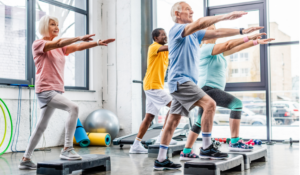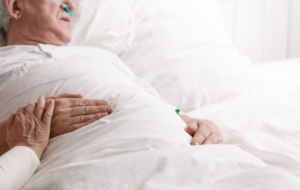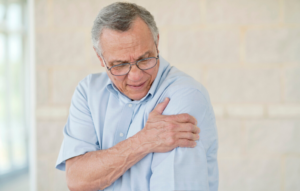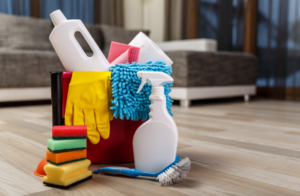Bacteria, viruses and other germs can pose a threat to anyone who enters your facility or business. But no one is at a higher risk of contracting an infection or sickness than senior citizens. Common infections in the elderly can be life-threatening and dangerous. The CDC indicates this is because as people get older their immune systems don’t work as well.
For managers and business owners who operate or oversee a publicly shared space such as a fitness facility, community center, corporate office or hotel, protecting senior citizens is oftentimes not as high a priority as it is for health care and assisted living facilities. Whereas long term care and retirement homes know about common infections in the elderly population, other businesses may not.
WHY DO ELDERLY ADULTS GET SICK EASILY?
As we age, our immune systems naturally weaken. Weakened immune systems make it more difficult for the body to fight off infections. Something as simple as the common cold can be dangerous to adults over the age of 65. Additionally, elderly adults may suffer from other health complications, which further weakens the body’s immune response. Overall, a weakened immune response paired with the onset of chronic diseases make it easier for the elderly to get sick than other age groups.

WHERE ARE COMMON INFECTIONS IN THE ELDERLY MOST LIKELY TO OCCUR?
Because of their heightened susceptibility to contracting infections, elderly adults need to be cautious of certain facilities and environments.
Most facilities are full of high-touch surfaces that serve as conduits for the spread of germs. Additionally, skin-to-surface contact can be especially dangerous in spreading common infections in the elderly. This includes deadly infections such as MRSA and other staph infections.
Facilities at risk of spreading infections to elderly adults include:
- Gyms and fitness centers
- Medical and healthcare facilities such as hospitals, physical therapy, and urgent care
- Retirement Homes
- Spas
- Hotels
However, infections can spread to the elderly in schools, offices, grocery stores, and other areas as well. Any public environment where germs roam freely are high-risk spaces for elderly adults to contract potentially life-threatening infections.

TOP 3 COMMON INFECTIONS IN THE ELDERLY
While many infections affect the elderly at higher rates than the rest of our population, these are the most three common.
PNEUMONIA
An estimated 150,000 hospitalizations occur annually from pneumonia in the U.S. and the majority of them occur in the elderly. Pneumonia is especially dangerous for elderly adults because it can trigger complications that are challenging to treat. Peaking alongside cold and flu season, pneumonia cases spike October through March. It often develops as a secondary infection after a cold or flu infection, making rhinovirus and Influenza germs even more dangerous.
Symptoms of pneumonia include severe cough accompanied by colored mucus, shortness of or shallow breath, chest pain that intensifies with breathing or coughing, and general malaise. However, confusion is the symptom most common in the elderly. Interestingly, seniors generally experience fewer symptoms because of their naturally weakened immune systems. This gives the infection time to worsen and spread to other parts of the body, including the heart before doctors can treat the problem.
Further complicating the danger of pneumonia in the elderly, finding suitable antibiotics to treat it, when caught in time, is difficult because of the many complications that come with finding an antibiotic that won’t adversely affect the prescriptions they’re currently taking. It’s no wonder that doctors consider pneumonia in elderly adults on the same level of seriousness as a heart attack.

INFLUENZA
20,000 deaths are caused by influenza (the flu) each year. Of that number, 80 to 90 percent are elderly adults. Not only can influenza lead to complications from secondary infections like pneumonia, but it can also trigger respiratory complications. Influenza also affects those with pre-existing diseases like diabetes, kidney disease, or heart diseases much more intensely. Counterintuitively, the flu is more common in cold weather.
Since the Influenza virus can live up to 24 hours on non-porous surfaces like tables, door handles, gym equipment, and other high-touch surfaces, once it enters your facility it can spread rapidly. Most common infections in the elderly spread through contact but influenza is most commonly spread through the air via people sneezing, coughing and talking.
Along with fever and chills, persistent cough, and other symptoms, those who are over 65 years old risk a different set of problems – primarily the risk of developing secondary infections and complications as the body struggles to fight off these aggressive germs. These complications include lung infections that lead to blood poisoning and organ failure, inflammation of the heart, brain, and other critical organs.

SKIN INFECTIONS
Nearly 40 percent of people who suffer staph and MRSA infections each year are over 75 years old. MRSA is an antibiotic-resistant superbug strain of staph bacteria that causes deadly blood infections and organ failure, among other complications. While around 2 percent of the general population carries MRSA, in nursing homes, that figure is closer to 25 percent. To make this even more alarming, many carriers have no symptoms and can unknowingly spread the infection by skin-to-skin and skin-to-surface contact.
MRSA and staph infection symptoms include skin that’s sensitive to the touch and may show open sores, chest pains, abnormal cough, difficulty breathing, extreme fatigue, fever and chills, headaches, rashes, and wounds that won’t heal. Senior citizens are especially in danger if they contract one of these skin diseases. The antibiotic-resistant nature of MRSA makes it difficult to treat so finding effective antibiotics that don’t interfere with any medicines the patient already takes can be challenging.
They’re also more likely to develop life-threatening complications because of these common infections in the elderly. And often, because of their weakened immune systems or preexisting chronic disease, it’s easy to misdiagnose these skin infections, not seeking proper treatment until it’s too late.

PREVENTING COMMON INFECTIONS FOR OLDER ADULTS
The best way to prevent spreading common infections in the elderly is to follow a few steps. These crucial, potentially life-saving steps include:
- Cleaning and disinfecting surfaces and equipment several times a week, being sure surfaces remain wet for the dwell time listed on the label to kill specific germs
- Focusing disinfecting efforts on high-touch surfaces like door handles or community-shared equipment such as yoga mats.
- Making sure areas and spaces specifically for senior citizens and other high-risk guests who use your facility are always clean, sanitized, and disinfected.

EVERYONE SHOULD FEEL SAFE IN YOUR FACILITY
Senior citizens and elderly adults are our beloved parents, grandparents, great-grandparents, mentors, teachers and so much more. They deserve to feel safe, secure and protected from germs along with everyone else who visits or spends time at your facility or business. Intentional cleaning is key to making sure bacteria, viruses and fungi are eliminated to prevent infection and sickness in people of all ages.
